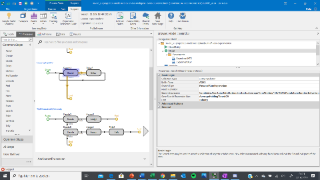Search the Community
Showing results for 'entity api'.
-
I have attached a simple example of one approach. 1) I edited the ModelEntity object and added a state array of type MatrixFromTable. This type of array is automatically initialized from a table. Ideally I might have also added a table to the entity, but Simio doesn't work that way. Instead, I added a RepeatGroup named InitializationValues consisting of a Real property. I used this repeat group as a way to essentially add a "table" into the object, since internal to Simio there is almost no difference between a table and a repeat group. 2) Back in the model I added a table and then imported data into that table from Excel. I used 10 rows, but I could have imported 350 rows with no change to anything else. 3) Now when you place the ModelEntity object into a model, you can pass a table into the InitializationValues repeat group. Again, intead of just typing a bunch of values into the repeat group, I just say go get the whole repeat group from a specified table. This has the result of sizing that state array inside the model entity to match the current size of the table, and then initializing the state values to whatever is in the table. 4) If you run the model, you can open the Watch window on any entity and view the values of its states. I expect this won't solve all your problems, but maybe it will give you a fresh approach to consider. ImportStateValues.spfx ImportStateValues.xlsx
- 2 replies
-
- 1
-

-
- state array
- repeat group
-
(and 4 more)
Tagged with:
-
Hi, We have a model where we have multiple entity states. This creates interface challenges in defining and populating these states or changing many of them at a time. My question is, can the UI be bypassed in some way using some kind of batch operations? For example suppose I want to assign 150 entity states using string construction and naming conventions easily set up in a spreadsheet. Is there a way to define all those states and import them from a file rather than hand editing each one in the Definitions UI? Another example is I want to set large numbers of these states at appropriate points in processing. Is there any way to do so by just importing name value pairs from a file rather than hand editing each one and copy pasting from a spreadsheet built up accordingly. Thanks Very Much, Jim
- 2 replies
-
- state array
- repeat group
-
(and 4 more)
Tagged with:
-
Modify Fixed route vehicle's destination with Set Row
Mahe replied to Mahe's topic in SI General Discussions
Hi, Thank you for your answer. But my problem is not on the first Source. My proble is for the source "Source_Aub_Char" and "Source_Aub_de". The fifth vehicle don't pick up the entity waiting in the sources' Queue. Thank you. -
Dear Simio employee, I have two questions about 'getting' the average holding time for all the realisations of my subclassed vehicle. I want to know how long an entity is on a vehicle, on average. I tried it with two processes, but both don't work. I don't understand why the following doesn't work (process GemTijdOpAGV): And I also don't understand why the process TijdContainerOpVoertuig doesn't work. I don't understand the error: 'Model Entity does not match the model', or something like that. I created two instances of de model entity, named 'container and pallet', but it seems like I can't use model entity in some processes and in others I can. Why is that and when can you use model entity and when not? (This is also true for instances of a vehicle.) I have attached the model below, but it is still in progress. I hope to hear from you soon! With kind regards, Thomas Haven_v1 project DS model met RS en dus intelligent MTS.spfx
-
You can just use a process with a WAIT step. On entity arrival you will fire and event and the process will go on. I also belive that a worker is derived from entity so you can use workers instead of entities. Or the best fitting thing is to use consume step to consume a material (the tools). And have two inventories for it (one near the machine, one in the warehouse of tools). There are some simbits with the basic inventory concepts.
-
I am trying to model a repair process. A major part of this process is the time to get the tools from their storage locations to the machine that needs repair. My thought was to have the tools be modeled as entities that a fork lift or worker has to go grab and bring back to the server. The problem is I need to wait for all those entities to be there before the server can start to process. Then I want to destroy the entities because they aren't actually being processed (only 1 entity would be processed as a representation). Does anyone have a suggestion on how this might be accomplished? Thanks.
-
To keep things simple, let's just say I have two servers. At these two servers are 3 resources each: Server A has Resource 1, 2, and 3, and Server B has Resource 4, 5, and 6. I have a pre-determined list of Resources that needs to be selected. For example, the Entity would need to go to Server A to select Resource 2 and then Server B to select Resource 4 and then exit. I need help with the logic to help make this work. But then, once the order is finished, the resources to capture changes so the entity might have to go to Server B to get Resource 6 and then Server A to get Resource 1, then to the sink. In the big scheme of things, I'm going to have many Servers and each Server is going to have at least 4 Resources. I'm trying to figure out how to do this in the most efficient way whether it be through lists or built in properties. Thanks in advance!
-
Hi Jeff, I am studying your model right now and I would like to kindly ask you If you could explain to me some aspects of it. 1. when you add the InfrequentFailureType property inside the multifailureserver model, why is this property a list? I do not understand this. 2. If I want, in this case, my FILLERS, to have 2 types of failures, both triggered by amounts of weight filled to container entities (this is the ideal, but it could also be by number of times that filler fills the container entity), what should I have to change from your model? Thank you so much! Tere
-
I would suggest to expand this model I sent before by creating new states inside your ModelEntity. Two states when the entity leaves a station (one updates the station name and one updates the time it left). A state when the entity enters a station. Maybe another states registering how many rows in your sheet were written. The columns of your sheet would be ModelEnity.FromStation, ModelEntity.ToStation and (ModelEntity.TimeLeftStation - TimeNow). Let me know if you need help building this model.
-
I have a model where I have 7(seven) entities and for each entity there are many possibilities paths. Is possible an entity be programmed with multiple sequences tables? For example, the entity can go to source -> server1 -> sink, and also randomly it can go to source -> server2-> sink, something like that.
-
Change processing time depending on previous server output
Wsimio replied to Wsimio's topic in SI General Discussions
Thank you, i used the server1.failure.active expression. However, i want to use the average server productivity and not an entity dependent time. How would you express the productivity of a server in a model state variable? -
Thanks Gustavo, actually what worked for me was ContainerEntity.Location.Parent.Name! Anyway thank you very much. I have another doubt which I think is far more complicated. I have two "streets" with a container entity moving moving along each of them. This streets have both fillers and emptiers, and I wish to write in excel every time a container entity goes from a filler to an emptier and how long that took. For example if my container on street 1 goes from filler_2 to emptier_6 I would like a row in excel with those 3 columns: starting filler, ending emptier and time between. I achieved this without problem for one of the streets (adding add on process triggers to all of the fillers and another for all of the emptiers). The thing is when I add this same processes to the emptiers/fillers of street 2, my excel goes crazy and obviously because of two reasons: the time I register to calculate time between is being updated in both streets every time a container goes out of an emptier, and exactly the same happens with the row that this 3 things have to be written in the excel. I don't know hoy I can manage to construct the variables time and row_count without them getting confused and hence my excel becoming useless. Thanks, again!!!
-
Wait, actually this doesn't work. Check the attached model: Create a new ContainerEntity with a string state named whatever you like; Assign NewContainerEntity.NewStringState = Filler.Name when entering the filler. Use this expression any time you need the name of the last station that entity visited. Get Station Name.spfx
-
ModelEntity.CurrentStation.Name Be aware that this will return an error in the case the entity is not at a station.
-
Hi, I have several sources that create the same container entity, yet every container entity created carries out different tasks throughout the model. I would like to change properties of specific container entities, for example, each time the container entity in "lane 1" gets filled, it changes the speed of that container entity (not of all the population of container entities). How can I do this? Thank you!!!
-
Hi!! I want to know in which object (in this case filler) my container entity is when certain event occurs. Is there a way to access this info? Thank you so much! Teresita
-

Change processing time depending on previous server output
GFurtado replied to Wsimio's topic in SI General Discussions
Open your ModelEntity and add a new Real State variable named TimeInServer1 or whatever; Set ModelEntity.TimeInServer1 = TimeNow when the entity enters Server1; Set ModelEntity.TimeInServer1 = TimeNow - ModelEntity.TimeInServer1 when the entity exits Server1; Set Server2 processing time to ModelEntity.TimeInServer1 * E + delay (hours). Check the attached model for some extra help. Register Server1 Processing Time.spfx -
********************* FOR VERSION 191 AND LATER ******************************* In Sprint 191, a change was made to the Seize step's On Seized Process and the Release step's On Released Process which impacted the Token Associated and Context Objects. This change effects the logic in VehicleX. For use in Simio versions 190 and earlier, please use the files at the top of this thread. Attached is an updated VehicleX (now VehicleX3) for use in Simio 191 and later, as well as the updated examples using VehicleX3. VehicleX3 now will reject an Entity's Transport Request if an operator is not available for that vehicle. This prevents entities from seizing and waiting for an unmanned vehicle. *************************************************************************************** VehicleX3.spfx VehicleWithDriver_VehicleX3_Examples.spfx
-
Hello all, In my model, I have a pool of secondary resources representing Firms. Order entities with random amounts arrive from a source, targeting randomly selected firms. The amount in each Order entity is registered in a state value vector (called "FirmDemands" with a row for each firm) as the demand for its target firm. I would like to direct Product entities coming from a different source to the firms according to their present level of demands. I suppose I could use "Select from List" option, but how would I refer to that state value vector in the selection expression so that a product will be assigned to the firm with the highest demand at that time?
-

Waiting on the path if there is no seat in input buffer
asneath replied to Sea Jung's topic in SI General Discussions
I noticed that the Source is not making just two entities, as you stated, it is actually making several as governed by your Interarrival Time. But since you have Output@Source1 (TransferNode) Blocked Destination Rule set to 'Select Available Only', all entities created after the first two are waiting until one of the Servers has finished processing. You will notice that once Server1 has finished processing, an entity is released from the Source (since its destination has been assigned). I would recommend exploring this further by enabling 'Model Trace', from the Run Ribbon, to see what is happening behind the scenes. Happy modeling! -

Off Shift Rule Secondary Resources
asneath replied to james.waller's topic in SI General Discussions
Double check that each Resource is hooked to the correct Work Schedule, and that you have the intended Day Pattern inputs for Mon - Sun in your Work Schedule(s). It sounds like you might need a separate (two total) Work Schedule for each group of 5 Resources. I would also recommend visually verifying that the Resources go OffShift (turn white) at the intended times. Other than that just make sure that the Off Shift Rule, in the Server's Secondary Resources, is also set to 'Suspend Processing'. Another way to check that the Server has suspended processing is to put some Dynamic Label Text on the Entity like 'ModelEntity.ID' so you can see exactly which Entity is in the Processing.Contents queue of the Server before and after the shift change. It should be the same one! Happy modeling! -
Hello, I have selected Suspend Processing in the Off Shift Rule portion of my server modules but when I use a Status Label to indicate the Resource.Capacity.Utilized / Resource.Capacity, it appears as though the resources are not going off shift until after processing the entity in the server calling on the secondary resource. What else do I need to do? I'd like for the Resource to go off shift (and not finish the process) according to the Work Schedule assigned to it and then pick back up the processing of the entity when it gets back on shift. I've looked into several other posts but they seem to be outdated. Thanks!
-
I am trying a simple assembly process where 2 entities are to be assembled to create a 3rd Entity. Hence I need to destroy 2 entities arriving at the server and create 3rd pre-defined entity. Can someone please help with how this can be achieved?
-
You can use seperate servers (each has 1 capacity) each represents individual firms. Create entities (raw products) via a data table where you should also include one column (a node property from object reference property) to represent where the created entity will be processed (as its destination). Then at the output node of the source object set entity destination type property to specific. Then set node name to Table1.NodeInstanceProperty1. The entities will be routed appropriately.
-
I am working on a simulation of a number of firms processing raw products. If I represent the firms as resources in a server -so that the server capacity represents the number of firms, how could I identify which resource/firm processed a certain batch of products? Can this be done with a server having a capacity of its own, or should I use a pool of (secondary) resources with id labels so I can use that id to label the product batch?





